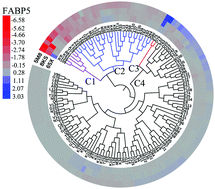当前位置:
X-MOL 学术
›
Phys. Chem. Chem. Phys.
›
论文详情
Our official English website, www.x-mol.net, welcomes your feedback! (Note: you will need to create a separate account there.)
Molecular mechanism with regard to the binding selectivity of inhibitors toward FABP5 and FABP7 explored by multiple short molecular dynamics simulations and free energy analyses.
Physical Chemistry Chemical Physics ( IF 3.3 ) Pub Date : 2020-01-09 , DOI: 10.1039/c9cp05704h Jianzhong Chen 1 , Xinguo Liu 2 , Shaolong Zhang 2 , Junxiao Chen 3 , Haibo Sun 1 , Lin Zhang 4 , Qinggang Zhang 2
Physical Chemistry Chemical Physics ( IF 3.3 ) Pub Date : 2020-01-09 , DOI: 10.1039/c9cp05704h Jianzhong Chen 1 , Xinguo Liu 2 , Shaolong Zhang 2 , Junxiao Chen 3 , Haibo Sun 1 , Lin Zhang 4 , Qinggang Zhang 2
Affiliation

|
Recently, fatty acid binding proteins 5 and 7 (FABP5 and FABP7) have been regarded as the prospective targets for clinically treating multiple diseases related to FABPs. In this work, multiple short molecular dynamics (MSMD) simulations followed by binding free energy calculations were performed to investigate the binding selectivity of three inhibitors, namely, 65X, 8KS, and 5M8 toward FABP5 and FABP7. The RMSF analysis suggests that the structural flexibility of FABP5 is stronger than that of FABP7; moreover, the calculated molecular surface area of FABP5 is also larger than that of FABP7. Meanwhile, the results from the cross-correlation analysis show that the inhibitor bindings exert different impacts on the internal dynamics of FABP5 and FABP7. Binding free energies predicted by the molecular mechanics/generalized Born surface area (MM-GBSA) method indicate that the increase in the enthalpy changes caused by the bindings of inhibitors toward FABP7 relative to FABP5 mostly drives the binding selectivity of the inhibitors toward FABP5 versus FABP7. Hierarchical clustering analysis based on the energy contributions of separate residues and calculations of residue-based free energy decompositions were carried out by using the equilibrated MSMD trajectories. The obtained results not only recognize the hot interaction spots of inhibitors with FABP5 and FABP7, but also display that several common residues, namely, (T56, T54), (L60, F58), (E75, E73), (A76, A78), (D79, D77), (R81, R79), (R107, R109), (C120, L118), and (R129, R127) belonging to (FABP5, FABP7) induce obvious binding differences in the inhibitors toward FABP5 and FABP7. Therefore, these residues play significant roles in the binding selectivities of inhibitors toward FABP5 and FABP7.
中文翻译:

通过多次短分子动力学模拟和自由能分析,探索了抑制剂对FABP5和FABP7的结合选择性的分子机理。
近来,脂肪酸结合蛋白5和7(FABP5和FABP7)已被认为是临床治疗与FABP相关的多种疾病的预期靶标。在这项工作中,进行了多个短分子动力学(MSMD)模拟,然后进行结合自由能计算,以研究三种抑制剂,即65X,8KS和5M8对FABP5和FABP7的结合选择性。RMSF分析表明,FABP5的结构柔韧性强于FABP7。此外,FABP5的计算的分子表面积也大于FABP7的。同时,互相关分析的结果表明抑制剂的结合对FABP5和FABP7的内部动力学有不同的影响。通过分子力学/广义玻恩表面积(MM-GBSA)方法预测的结合自由能表明,相对于FABP5,抑制剂与FABP5的结合引起的焓变增加主要驱动抑制剂相对于FABP5与FABP7的结合选择性。 。利用平衡的MSMD轨迹,进行了基于单独残基能量贡献的层次聚类分析,并计算了基于残基的自由能分解。获得的结果不仅识别抑制剂与FABP5和FABP7的热相互作用点,而且显示出几个常见的残基,即(T56,T54),(L60,F58),(E75,E73),(A76,A78)属于(FABP5)的(D79,D77),(R81,R79),(R107,R109),(C120,L118)和(R129,R127)FABP7)诱导抑制剂对FABP5和FABP7的明显结合差异。因此,这些残基在抑制剂对FABP5和FABP7的结合选择性中起重要作用。
更新日期:2020-01-09
中文翻译:

通过多次短分子动力学模拟和自由能分析,探索了抑制剂对FABP5和FABP7的结合选择性的分子机理。
近来,脂肪酸结合蛋白5和7(FABP5和FABP7)已被认为是临床治疗与FABP相关的多种疾病的预期靶标。在这项工作中,进行了多个短分子动力学(MSMD)模拟,然后进行结合自由能计算,以研究三种抑制剂,即65X,8KS和5M8对FABP5和FABP7的结合选择性。RMSF分析表明,FABP5的结构柔韧性强于FABP7。此外,FABP5的计算的分子表面积也大于FABP7的。同时,互相关分析的结果表明抑制剂的结合对FABP5和FABP7的内部动力学有不同的影响。通过分子力学/广义玻恩表面积(MM-GBSA)方法预测的结合自由能表明,相对于FABP5,抑制剂与FABP5的结合引起的焓变增加主要驱动抑制剂相对于FABP5与FABP7的结合选择性。 。利用平衡的MSMD轨迹,进行了基于单独残基能量贡献的层次聚类分析,并计算了基于残基的自由能分解。获得的结果不仅识别抑制剂与FABP5和FABP7的热相互作用点,而且显示出几个常见的残基,即(T56,T54),(L60,F58),(E75,E73),(A76,A78)属于(FABP5)的(D79,D77),(R81,R79),(R107,R109),(C120,L118)和(R129,R127)FABP7)诱导抑制剂对FABP5和FABP7的明显结合差异。因此,这些残基在抑制剂对FABP5和FABP7的结合选择性中起重要作用。



























 京公网安备 11010802027423号
京公网安备 11010802027423号